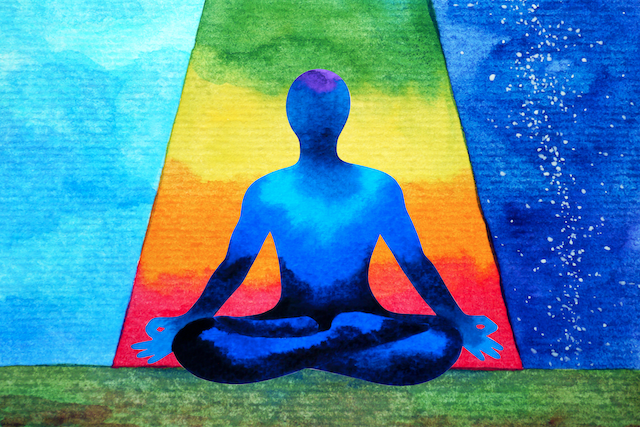
“Attention is the rarest and purest form of generosity.” ~Simone Weil
It’s so easy in our busy, results-driven world to lose track of ourselves in a drive to address the needs of others. What with your work performance demands, evening dinner preparation, the Facebook post from a friend that requires your response before the sender gets upset… Wow, I’m feeling overwhelmed just writing about it!
The world demands our constant attention, and we willingly give it. But what about attention to ourselves?
Underneath every hood is an engine, behind any piece of artwork is the artist, and beneath your ability to respond to the world is your mental and physical energy stores.
Have you ever said or heard someone say that you just “don’t have the energy”? Well, it may not be as metaphorical as you think. Giving attention to the ‘noise’ in your daily life takes energy, and unless you devote time to a restorative practice, such as meditation, your energy stores run low.
So, if you’re like me and have nurtured the compulsive desire to cast the majority of your attention outward rather than inward, what happened? What was the result of your mental energy running low?
After focusing most of my energy outward for years, I developed a series of self-destructive traits.
I became short-tempered and negative, lost hope and mental drive, became ungrateful, introverted, and moody, lacked energy, and was in an unhappy and unproductive state for much of my day.
All this changed when I discovered meditation. It was the dose of self-love and attention that I needed to recharge my emotional tank so I could determine what was important, get the most out of my day, and achieve the success that I wanted, not what others wanted from me.
Aside from a mental recharge, there are plenty of other benefits that I’ve experienced from my practice, including:
- Relief of anxiety
- Providing clearer thoughts
- Slowing down reaction to stimulation—being more patient
- Increase recognition of compulsive behavior patterns
- Gain in confidence and self-assurance
- Increase in productivity
- A happier, more positive outlook
Meditation really is, in many ways, maintenance for the mind. Think of your mind as your car. You could put off changing the oil, thinking, “Well, if I just let it go another few weeks to save some money, it’ll be fine.”
Yes, it could be fine, but chances are you’re going to keep putting it off again and again, since you’ve had no reason to worry so far.
What you can’t see is that your oil accumulates carbon and wear particles, and undergoes degradation so that eventually, it causes a critical failure of your car. You haven’t given your car the attention it requires to serve you effectively, and as such, the poor oil quality has led to a ‘meltdown’ of the engine.
Your mind requires similar attention—maintenance to keep it running effectively, efficiently, and without risk of a ‘meltdown’ (think depression or anxiety attack).
How can you expect to access your true inner brilliance if you constantly have a mess bouncing around inside of your head? The key is to quiet the buzz with the attention your mind deserves through meditation, and let the quality thoughts roam free in the space that’s created.
5 Foolproof Steps to Meditation
There are many types of popular meditation practices, but the one that I use is a form of mindfulness and Zen meditation based on the book The 8-Minute Meditation, by Victor Davich. The following is a step-by-step guide that I use each and every morning, with excellent results.
1. Clear your mind.
As part of my morning routine, I like to perform stretching in the form of the yoga Sun Salutation sequence. This releases the tension in my body and enriches my blood with fresh flowing oxygen, which is essential for building strong neuron bonds in my brain. This assists in clearing my mind before my meditation practice.
2. Get seated.
You may think meditation is all about being cross-legged on pillows, surrounded by candles and the strong smell of burning incense. Not true.
I find a comfortable, quiet place to sit normally and comfortably so that I don’t become overwhelmed with tingling in my legs, sore muscles, or anything else that may prove a distraction. My favorite places are either a flat chair or the edge of my bed.
3. Set your goal.
I use a stopwatch app on my phone to set the duration of my meditation practice at ten minutes. I’m busy, as I’m sure you are too, so I don’t like to sit and meditate for long periods of time. I’ve got stuff to do!
I recommend starting out small at first. If you think you can meditate for five minutes, go for three instead. Picking a goal that lies below your expectations sets you up to win, which is important when building a new habit.
After two years meditating, I find that ten minutes works well, and longer is even better (if you have time for it). You’ll achieve noticeable results at five minutes and above. TIP: Make sure your phone is on Airplane Mode to ensure you’re not interrupted.
4. Relax into position.
Once you’ve set your stopwatch, get seated and relax into position. Sit with a straight back, relaxed limbs, feet flat on the floor, palms face down resting on your knees. Part of meditation is creating a sense of grounding yourself with the here and now, so focus on the pressure applied through your buttocks and feet as they intercept the physical world.
Do a few neck rotations and when you’re ready, start your stopwatch, gently close your eyes, and relax.
5. Meditate. (Warning: Your mind will wander, and that’s perfectly fine.)
In the early stages of developing your practice, be patient. You will likely encounter resistance from your busy mind as it rejects your attempts at finding peace. If you’re finding it hard to stay focused on your practice:
- Pretend you’re cross-eyed and staring at the end of your nose. This is used in yoga as a point of focus, and it can help centralize your thinking, bringing it back to neutral.
- Focus on your breath. Pretend you’re watching air enter your nostrils. Feel its cool, oxygen-rich presence as you inhale and exhale slowly and steadily.
- Watch your pressure points. The pressure you’re applying to the physical world is another great focal point to centralize your thoughts. While you’re sitting, these might be the soles of your feet, the palms of your hands, and your buttocks. Notice how the pressure feels, and picture its integration with the earth to which you are intimately connected.
- Picture yourself from above. If you find yourself caught up in a thought, practice pressing pause and then picturing yourself looking down from a high location, say from a hot air balloon. As you watch, place your thought inside a bubble, and watch it float up toward you, then pop it, making it disappear. In doing this you’re seeing yourself from an outside perspective, and removing yourself from the thought.
You Need Self-Love and Attention; Meditation Is the Answer
If you thought meditation was an airy-fairy thing that only spiritual people or monks do, think again. There are many successful people that have realized the power of a meditation practice in their daily lives, including Oprah Winfrey and Steve Jobs, and many more that attribute their success to this essential morning habit.
Meditation will recharge your mental tank and give you the edge. It is a purposeful time in the day for you to focus on nothing in particular and in the process, give your mind some much needed time off.
Above all, giving yourself attention through meditation is the only way to truly recharge your mental capacity and address the root cause of your destiny—your power of thought and decision.
The silence will help you gain perspective on what’s truly important in the moment, and prioritize your time according to thoughts of success, not of mayhem.
About Jason Townsend
Jason Townsend is the founder of Kickstart a Cause, teaching you how to unlock your true potential and create the life you were born to live.













 Though I run this site, it is not mine. It's ours. It's not about me. It's about us. Your stories and your wisdom are just as meaningful as mine.
Though I run this site, it is not mine. It's ours. It's not about me. It's about us. Your stories and your wisdom are just as meaningful as mine.